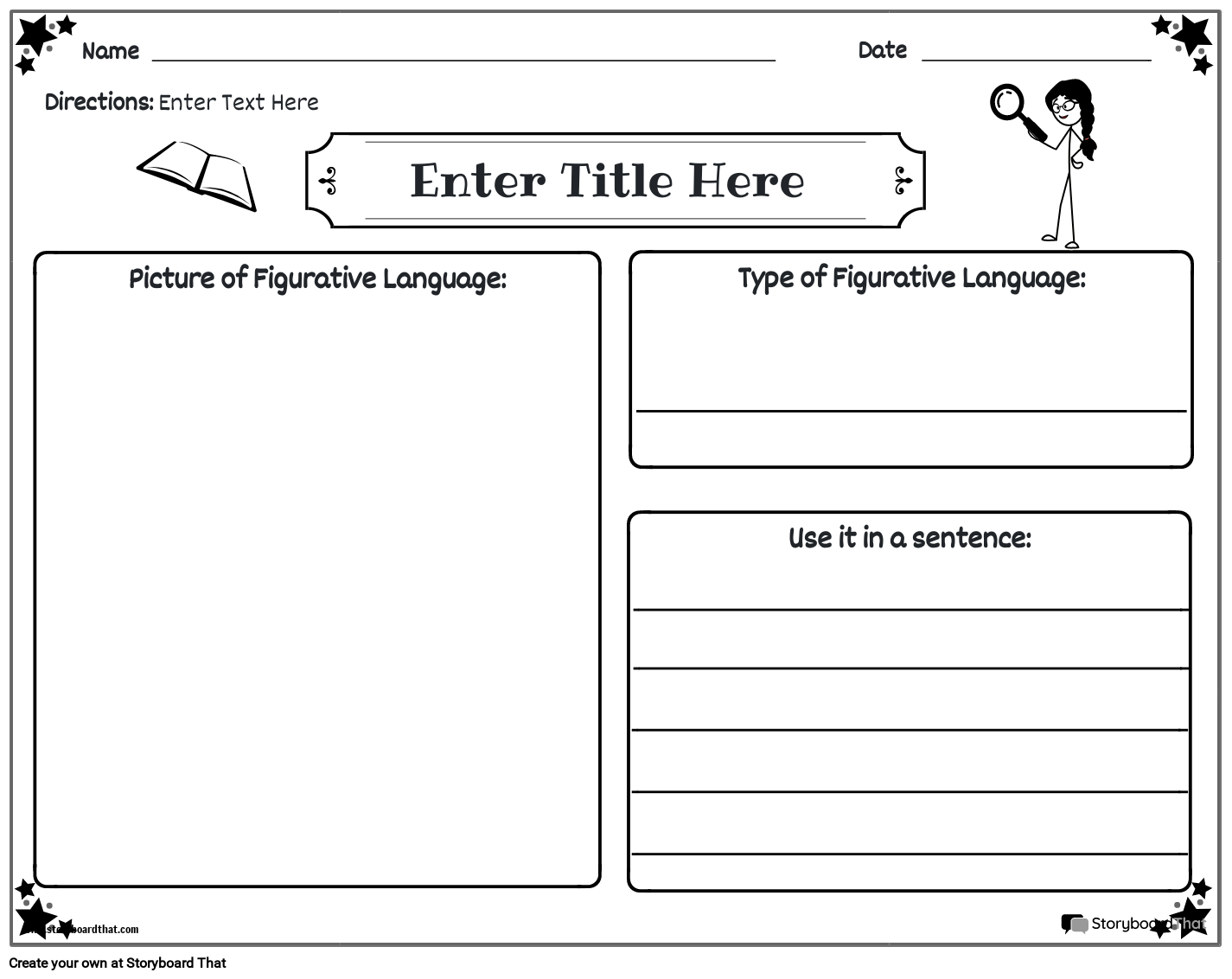Customize Figurative Language Worksheets
If you're assigning this to your students, copy the worksheet to your account and save. When creating an assignment, just select it as a template!

What is Figurative Language?
Figurative Language is a type of literary device that refers to phrases, sayings, or words that are not literally accurate, but important. Many writers use it to create layers of meaning that the reader accesses through senses, symbolism, and sound devices. There are several types of figurative language, but the most common types include simile, metaphor, personification, symbolism, paradox, hyperbole, and onomatopoeia. Our figurative language worksheet templates ask students to identify these types of language, and can be customized to fit any book or lesson for classroom use.
Why are Figurative Language Worksheets Important?
Figurative language templates help students identify figurative language elements in stories or poetry. Students can define each element of figurative language and then pull examples from the text for reference. Figurative language templates can also be used for students to create their own poetry or short stories!
Figurative Language Examples
Storyboard That has several examples of how figurative language is used in lessons and activities. In addition to printable figurative language worksheets, we have tons of ideas on how you can storyboard figurative language and have students work digitally. A few examples are listed below:
- Create a 3 cell storyboard that uses words and images to describe various types of figurative language, we have done in the wonderful book, Shiloh.
- Poetry often uses figurative language to give the words a greater depth and meaning. Maya Angelou does an exceptional job of this in ”Still I Rise”.
- Fantasy books such as The One and Only Ivan often include a great deal of figurative language.
- The Poet X uses a lot of metaphors and imagery.
- The book’s title, Fish in a Tree is a metaphor itself!
How to Make a Figurative Language Worksheet
Choose One of the Premade Figurative Language Templates
We have color, black and white, portrait, or landscape templates. Take a look at our figurative language example for inspiration!
Click on "Copy Template"
Once you do this, you will be directed to the storyboard creator.
Give Your Worksheet a Name!
Be sure to call it something related to the topic so that you can easily find it in the future.
Edit Your Worksheet
This is where you will include directions, specific questions and images, and make any aesthetic changes that you would like. The options are endless!
Click "Save and Exit"
When you are finished with your figurative language worksheet, click this button in the lower right hand corner to exit your storyboard.
Next Steps
From here you can print, download as a PDF, attach it to an assignment and use it digitally, and more!
Other Templates to Use with Students Today!
Do you love our printable figurative language worksheets and want more? Storyboard That has tons of worksheet and poster templates for all subjects and ages! Check out some of our favorites:
- Spelling Test Templates
- Timeline Worksheets
- Labeling Worksheet Maker
- Reading Log Worksheets
- Variables Worksheet Templates
- Social Studies Worksheets
- Education Infographic Templates
Do you want to see more? Check out our posters and other worksheet categories on our main Teacher Templates page!
Check out our Worksheet Template Gallery to browse our layouts!
Happy Creating!
Frequently Asked Questions about Figurative Language Worksheets
Can I make a figurative language chart with Storyboard That?
If you want your students to keep track of the different types of figurative language, you can absolutely make a chart! Our premade templates are perfect for figurative language exercises that require a chart to organize the words and phrases that students find.
What are the different types of figurative language techniques or types?
The main types of figurative language are as follows:
- Simile: A comparison of two things using the words “like” or “as”.
- Metaphor: A comparison of two things without the words “like” or “as”.
- Personification: The assigning of human qualities to an inanimate object, person, animal, or abstract idea.
- Symbolism: Uses objects, characters, and motifs to create a pattern of deeper meaning that stands out in the reader’s mind
- Hyperbole: An obvious exaggeration or overstatement to make a point.
- Oxymoron: Combines two contradictory words or ideas into one phrase to highlight an idea or a problematic connection for the reader
- Onomatopoeia: Words that imitate sounds.
Can I make a figurative language matching worksheet?
You sure can! Matching worksheets and identifying figurative language worksheets are a great way for visual learners to show what they know, when writing may be challenging for them. Teachers may choose to provide an answer key along with the figurative language identification worksheet.
Introductory School Offer
ONLY$500
- 1 School
- 5 Teachers for One Year
- 1 Hour of Virtual PD
30 Day Money Back Guarantee • New Customers Only • Full Price After Introductory Offer • Access is for 1 Calendar Year
© 2025 - Clever Prototypes, LLC - All rights reserved.
StoryboardThat is a trademark of Clever Prototypes, LLC, and Registered in U.S. Patent and Trademark Office

















